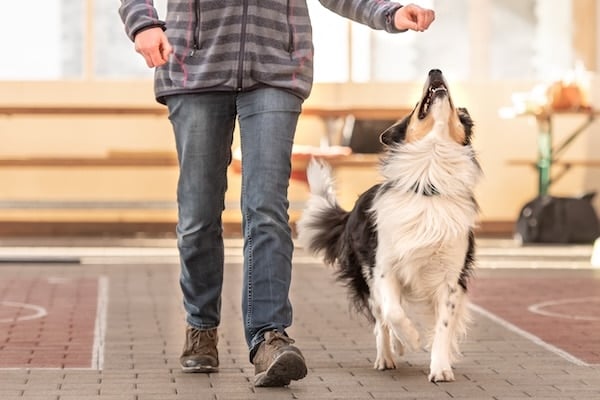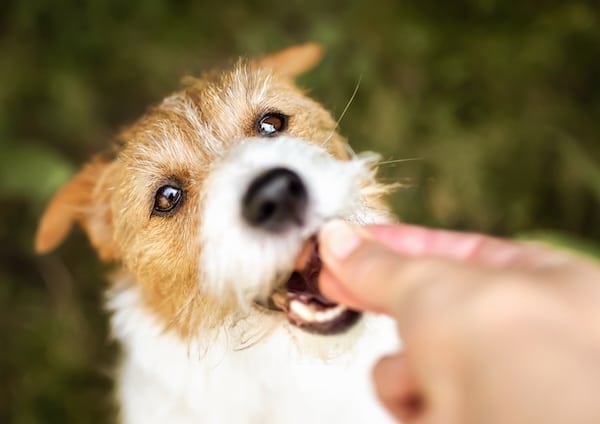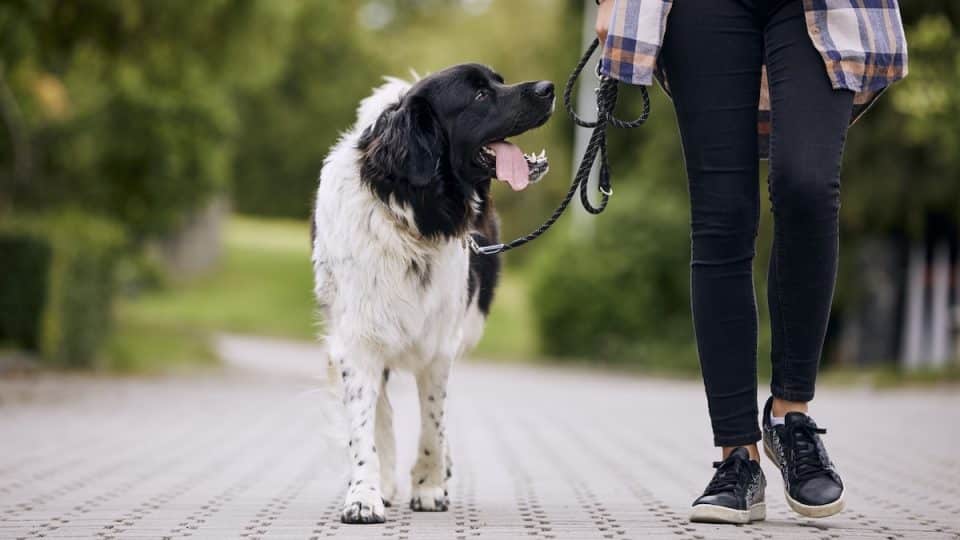- Not a substitute for professional veterinary help.
Dog walks are one of the best parts of having a furry companion. But as most new pet parents discover, there’s often a learning curve. A dog’s natural pulling and zig zagging on leash can make outings an exercise in frustration.
Loose leash walking is the art of having your dog stroll calmly beside or just ahead of you without putting pressure on the leash. This skill allows dogs to sniff and enjoy their surroundings while keeping walks relaxed and manageable for their handlers.
Although it takes time and effort to perfect, teaching loose leash walking is incredibly valuable. It can transform stressful walks into pleasant outings, making it easier for family members, friends, and sitters to walk your dog when you’re not around. Plus, loose leash training encourages cooperation and keeps you and your pup connected on walks.
With help from Carly Clarke, professional trainer and owner of Super Woofers Puppy & Dog Training, we’ll explain how to get started.
Equipment for Loose Leash Walking
Getting your dog to walk nicely on a loose leash starts with the right gear. Here’s what you’ll need.
- Leash. Choose a standard leash that’s around 6 feet long. Clarke explains that this length offers enough freedom for your dog, lets you maintain control, and helps achieve that relaxed “J” shape. Avoid retractable leashes, which create constant tension and may reinforce pulling.
- Harness. Clarke recommends using a two-point Y-front harness with both a front and top clip. Use the no-pull front clip during focused training sessions, then switch to the top clip for casual walks. This distinction helps your dog understand when it’s time to focus on training and when they can relax.
- Treats. Rewards are a powerful motivator and a key part of positive reinforcement training. Clarke suggests using high-value treats like chicken, cheese, or hot dogs during the early stages of training or in distracting environments. A treat pouch helps keep treats easily accessible for quick rewards.

K_Thalhofer via iStock
How To Teach Loose Leash Walking, Step by Step
Loose leash walking is a skill that takes time and practice to teach. But it doesn’t have to be complicated. Clarke breaks it down into three parts.
Part 1: Practice focusing on you
Your first goal is getting your dog to pay attention to you—even when distractions are present. Clarke suggests playing the “Focus Game.” This exercise teaches your dog that paying attention to you is rewarding and encourages them to check in with you periodically.
- Start in a quiet area with minimal distractions.
- Grab a handful of your dog’s favorite treats.
- Drop one treat on the ground and let your dog eat it.
- As soon as they glance back at you, say “yes” or use a clicker, then drop another treat.
- Continue this until your dog gets into a rhythm of looking at you and earning a reward.
Part 2: Walking backwards
Now that your dog is paying attention to you, it’s time to add movement. But instead of walking forward (which often encourages dogs to pull), Clarke suggests teaching them to walk backward first. This puts you in front of your dog, making it easier for them to stay focused on you.
- Stand facing your dog with treats in hand.
- Step backward and encourage your dog to follow you.
- When your dog follows, mark the behavior with a “yes” or click, and reward them with a treat.
- Keep moving backward for a few steps, rewarding your dog every few steps for sticking with you.
Part 3: Walking by your side
Once your dog can follow you backward, it’s time to shift to walking alongside you. At this point, your dog has learned to pay attention and follow your lead. “Now you’re simply transferring those skills to a traditional walking position,” explains Clarke.
- Stand with your dog at your side.
- Have your treats available.
- Start walking forward, rewarding your dog generously for staying close and keeping the leash slack.
- As your dog improves, gradually space out the treats, taking more steps before rewarding.
When should you reinforce your dog with treats?
As you work on loose leash training, try to stay present so you can capture and reinforce preferred behaviors. Mark and reward anything you want to continue to see, such as:
- Walking calmly beside you
- Staying in the desired position at your side
- Checking in with you regularly
- Ignoring distractions, like passing dogs and cyclists
How is loose leash walking different from a heel?
Many people confuse loose leash walking with a “heel” cue, but they serve different purposes in training.
Loose leash walking is more relaxed and allows your dog to walk beside or slightly ahead of you. Dogs can sniff and take in their surroundings as long as the leash stays loose (hence the name). This approach focuses on enjoying the walk together rather than maintaining a strict, controlled position.
In contrast, a heel requires your dog to stay close by your side and remain focused on your movements.
Both skills are important but are meant for different situations. For example, loose leash walking is perfect for relaxed neighborhood walks and longer outings, while a heel is ideal for shorter scenarios like crossing busy streets or navigating crowded areas.

Wavetop via iStock
Games & Tricks To Help with Loose Leash Walking
Walking your dog shouldn’t be a tedious chore. Adding some fun, loose leash walking games and tricks can make training sessions enjoyable for you both. Here are some simple ideas.
Stop and wait
When your dog pulls, stop walking. Remain still until your dog relaxes the leash by stepping back or looking at you. Once the leash is loose, reward them and continue your walk. This teaches them that pulling won’t get them anywhere.
Leash pressure
Some dogs, however, might get frustrated with the stop-and-wait game. A workaround to this is to actually teach your dog that the pressure they feel when they hit the end of their leash is the sign that they should come back to you. The leash pressure game works particularly well for dogs with high prey drives or who pull when overstimulated by things in the environment.
Change direction
Similarly, when you feel the leash tighten, simply turn around and head in the opposite direction. This sudden change grabs your dog’s attention and keeps them focused on you. As you pivot, you can use a fun cue like “Let’s go!” to get them to follow. When your dog returns to your side, reward them with a treat.
Circle around
Another solution to pulling: try walking in circles. This technique helps your dog slow down. As they cover familiar ground, it helps to diffuse excitement-based pulling. Remember to reward your dog for walking nicely.
Scatter feeding
When you scatter treats, it gets your dog to sniff and slow down, helping to calm them in stressful situations that might make them pull on the leash. You can use scatter feeding to redirect your dog when distractions pop up, they get overly excited, or they have a reaction. Once their brains have calmed down, you have a better chance of getting their attention back on you.
Long lines
Long leashes are your friend while teaching loose leash walking. Use a short leash when you’re practicing loose leash skills, and a long one when you’re not. That way, you prevent your dog from rehearsing unwanted behaviors like pulling. It can also signal to your dog when it’s time for a decompression walk versus a more structured and focused walk.
When a Trainer Can Help
A professional trainer can offer support if you’re struggling with your dog’s pulling, lunging, reactivity, or overexcitement on walks. Clarke explains that trainers can tailor their techniques to suit your dog’s unique personality, help you troubleshoot common challenges, and guide you through high-distraction settings.
The cost of training varies considerably, depending on the type you choose. Typically, four to six group classes cost around $300, while one-on-one sessions usually cost about $150 per hour. To see substantial improvement in your dog’s behavior, plan for multiple sessions.
Both in-person and online training have their pros and cons. In-person sessions offer hands-on guidance and instant feedback. Online training, on the other hand, tends to be more affordable since it eliminates travel expenses. It also offers flexible scheduling, making it easier to incorporate training into your routine.
If you’re feeling overwhelmed by it all, try not to get discouraged. Teaching your dog to walk on a loose leash takes consistent effort and won’t happen overnight. However, the reward of enjoyable walks makes it worthwhile!



